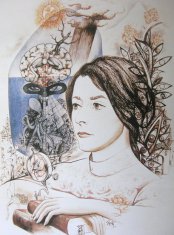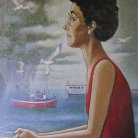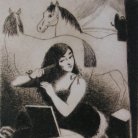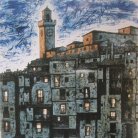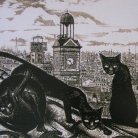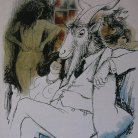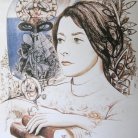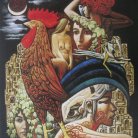Below you will find Lorenzo Goñi's biography in an english version. If you are interested in discovering the whole website in your own language please use a translation tool (e.g. google translation). Thanks for your understanding.
A BIOGRAPHICAL APPROACH
The life and work of Lorenzo Goñi -- some facts and commentaries
« I only hear my own murmurs »
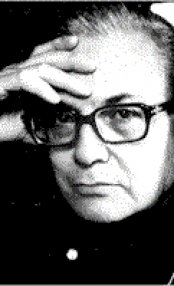
Lorenzo Goñi is undoubtedly the most important modern Spanish artist in the art of drawing. He is also the most original. He was born in Jaén in 1911, then shortly afterwards moved with his parents to Barcelona, where he began his first studies. Thanks to his family’s vast library he was introduced early to reading and became familiar with the important writers of the time, particularly with Pío Baroja, « whose work I have read down to the very last line », Goñi says himself.
As a child he contracted measles and as a result became progressively and incurably deaf. « When I was fourteen or fifteen years old I was already notoriously deaf and people had to shout for me to hear. » He felt totally isolated outside the family circle and his timidity rendered him incapable of having a normal social life.
Lorenzo Goñi, 1911-1992
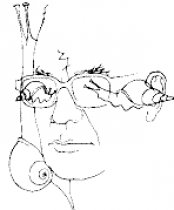
Lorenzo Goñi describes his drama, experienced at an age when impressions are most acute and unforgettable, as « the prisoner’s solitude ». His natural professional skill and the originality of his art were shaped by his deafness. This physical defect played an important role in his life, as it did in the often commented creative evolution of Goya and Beethoven. The unique and enchanting atmosphere of Goñi’s work, an atmosphere that swings between nightmare and nostalgia, is due to the deafness that exiled him to his own artistic world, a world that he forced himself to explore.
His father enrolled him in painting academies, where he drew still lives and nudes. In these exercises he would develop the ease and the astonishing assurance which years later would become one of hallmarks of his engravings and of his drawings. «I got tired of drawing those more or less flaccid tits, those bums of every size and those women in the twisted positions demanded of professional models », he says. Later he would draw female bodies from memory.
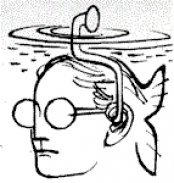
His mother died and his father remarried. From this second marriage his brother was born, but Goñi hardly had any contact with him when he grew up. His feeling of solitude intensified. He was called up for military service, but was declared unsuitable because of his hearing defect. After his father’s new marriage the family moved and Goñi was introduced to nature in the village of Vacarisas, a few kilometres away from Barcelona.
During one of his trips to the mountains a sad incident occurred which, in spite of its triviality, though trivial things are often those that are the most serious, filled Goñi with remorse during his entire life: with a stone, he killed a cat. The artist would fill his future compositions with cats, another hallmark of his art, “as a kind of obscure homage to my victim”.
When the Civil War started he went to work as a poster designer for the “Sindicat de Dibuixants Professionals” de UGT (a workers’ organization with a Marxist socialist ideology). This was an aspect of his creative career that remained unknown for a long time. Lorenzo Goñi himself, after that period of political strife, tried to “forget” that activity, to the point that even his best and most intimate friends, such as Camilo José Cela, knew nothing about it.
After the war, thanks to a friend of his family in Pamplona, where he had moved, Goñi found a job as a commercial artist for the journal “Haz”, a publication of the “SEU” (a government organisation). He signed his contributions with his mother’s name “Suárez del Árbol”, a name under which he was beginning to be known.
He met Conchita and married her. Four years later their only child, Inés, was born. “From then on”, he said, “my life went from strength to strength”.
One day he became tired of his borrowed signature and he returned to signing his work with his own name, “Goñi”. He was called by the newspaper “ABC”, one of the most important national newspapers, and his career started booming.
In 1953 he studied chalcographic engraving in the “Escuela Nacional de Artes Gráficas”, with Professor José de Castro Gil. Goñi would eventually master of the difficult technique of engraving and become one of the chief Spanish practitioners of this art.
In 1962 he obtained a bursary from the Fundación Juan March to realise his work “Tauromaquia onírica”, a splendid series of 13 engravings that have their place among the most significant works of art inspired by bullfighting since Goya.
Goñi’s artistic career continued unabated for the following years: he painted, published drawings in newspapers, won prizes and held exhibitions that were always received with admiration and wonder. From the beginning of the eighties Goñi devoted himself exclusively to painting and to engraving.
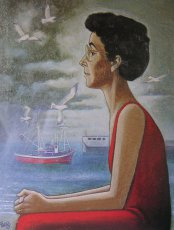
In 1989 his wife Conchita died. “My guide, my bridge to the loud world of those who hear has always been my wife. With her everything was easy and possible during the forty five years of our marriage. Now she has died and I am alone again”.
His daughter Inés takes him to live with her in Switzerland. There, in the city of Lausanne, he will die two years later.
He leaves over fifteen thousand engravings, drawings and oil paintings – who can count them? – that compose his artistic legacy.
Javier Rey de Sola, Valladolid, 2001
Conchita en Laredo, 1985

